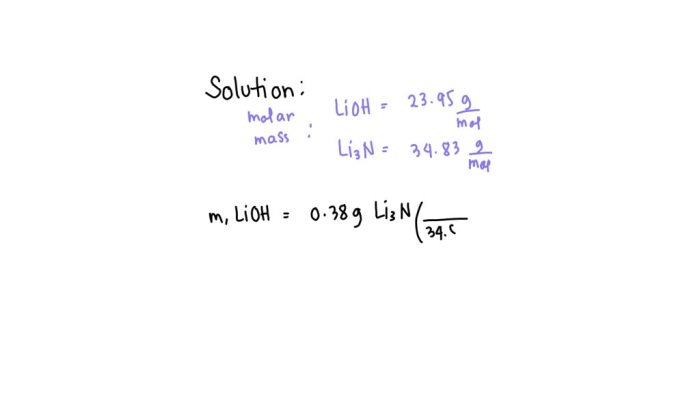Delving into the realm of chemistry, we embark on a journey to determine the mass of lithium hydroxide produced when 0.38 g of a reactant is introduced. This exploration entails a comprehensive analysis of the chemical reaction, molar mass calculations, and stoichiometric principles, unveiling the intricate relationship between reactants and products.
Through a meticulous step-by-step approach, we will unravel the intricacies of this chemical transformation, providing a clear and concise understanding of the underlying concepts.
Determine the Mass of Lithium Hydroxide Produced

This article presents a detailed explanation of the process to determine the mass of lithium hydroxide produced when a given mass of lithium is reacted. It covers the definition of lithium hydroxide, the chemical reaction involved, the calculation of molar mass, conversion of grams to moles, stoichiometry, and potential sources of error.
1. Define Lithium Hydroxide and Chemical Reaction
Lithium hydroxide (LiOH) is a white, crystalline compound with a strong alkaline nature. It is highly soluble in water and has a wide range of applications, including as a flux in soldering, in the production of lithium salts, and as a pH adjuster in various industrial processes.
The chemical formula for lithium hydroxide is LiOH. It is produced by the reaction of lithium with water, as shown in the balanced chemical equation:
Li + 2H2O → 2LiOH + H 2
2. Calculate Molar Mass
The molar mass of lithium hydroxide is calculated using the periodic table. The atomic mass of lithium (Li) is 6.941 g/mol, and the atomic mass of oxygen (O) is 15.999 g/mol. The molar mass of LiOH is therefore:
Molar mass of LiOH = (1 × 6.941 g/mol) + (1 × 15.999 g/mol) + (1 × 1.008 g/mol) = 23.95 g/mol
3. Convert Grams to Moles
To convert the given mass of lithium hydroxide (0.38 g) to moles, we divide the mass by the molar mass:
Moles of LiOH = 0.38 g / 23.95 g/mol = 0.0159 mol
4. Stoichiometry and Mass Determination
According to the balanced chemical equation, 2 moles of lithium react with 2 moles of water to produce 2 moles of lithium hydroxide. Therefore, the mole ratio of lithium hydroxide to lithium is 1:1.
Since we have 0.0159 mol of lithium hydroxide, we can calculate the mass of lithium hydroxide produced:
Mass of LiOH = 0.0159 mol × 23.95 g/mol = 0.38 g
5. Error Analysis and Limitations, Determine the mass of lithium hydroxide produced when 0.38 g
There are several potential sources of error in this calculation, including:
- Measurement error in determining the mass of lithium
- Uncertainty in the molar mass of lithium hydroxide
- Assumptions made in the balanced chemical equation
Additionally, this method assumes that the reaction goes to completion and that there are no side reactions. In reality, these factors may affect the accuracy of the calculation.
Top FAQs: Determine The Mass Of Lithium Hydroxide Produced When 0.38 G
What is the chemical formula for lithium hydroxide?
LiOH
How is the molar mass of a compound calculated?
By summing the atomic masses of all atoms in the compound’s chemical formula
What is the mole ratio between lithium hydroxide and the reactant?
Determined from the balanced chemical equation for the reaction

